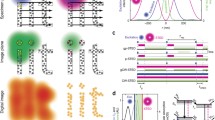Abstract
Applying pulsed excitation together with time-gated detection improves the fluorescence on-off contrast in continuous-wave stimulated emission depletion (CW-STED) microscopy, thus revealing finer details in fixed and living cells using moderate light intensities. This method also enables super-resolution fluorescence correlation spectroscopy with CW-STED beams, as demonstrated by quantifying the dynamics of labeled lipid molecules in the plasma membrane of living cells.



Similar content being viewed by others
References
Hell, S.W. & Wichmann, J. Opt. Lett. 19, 780–782 (1994).
Klar, T.A., Jakobs, S., Dyba, M., Egner, A. & Hell, S.W. Proc. Natl. Acad. Sci. USA 97, 8206–8210 (2000).
Hell, S.W. Nat. Methods 6, 24–32 (2009).
Eggeling, C. et al. Nature 457, 1159–1162 (2009).
Willig, K.I., Harke, B., Medda, R. & Hell, S.W. Nat. Methods 4, 915–918 (2007).
Moneron, G. et al. Opt. Express 18, 1302–1309 (2010).
Donnert, G. et al. Proc. Natl. Acad. Sci. USA 103, 11440–11445 (2006).
Leutenegger, M., Eggeling, C. & Hell, S.W. Opt. Express 18, 26417–26429 (2010).
Schrader, M. et al. Bioimaging 3, 147–153 (1995).
Westphal, V. & Hell, S.W. Phys. Rev. Lett. 94, 143903 (2005).
Auksorius, E. et al. Opt. Lett. 33, 113–115 (2008).
Hell, S.W., Jakobs, S. & Kastrup, L. Appl. Phys., A Mater. Sci. Process. 77, 859–860 (2003).
Ringemann, C. et al. N. J. Phys. 11, 103054 (2009).
Han, K.Y. et al. Nano Lett. 9, 3323–3329 (2009).
Jelezko, F. & Wrachtrup, J. Phys. Status Solidi A 203, 3207–3225 (2006).
Griesbeck, O., Baird, G.S., Campbell, R.E., Zacharias, D.A. & Tsien, R.Y. J. Biol. Chem. 276, 29188–29194 (2001).
Lamesch, P. et al. Genomics 89, 307–315 (2007).
Chiantia, S., Ries, J., Kahya, N. & Schwille, P. ChemPhysChem 7, 2409–2418 (2006).
Widengren, J., Mets, U. & Rigler, R. J. Phys. Chem. 99, 13368–13379 (1995).
Zander, C. et al. Appl. Phys. B 63, 517–523 (1996).
Maus, M. et al. Anal. Chem. 73, 2078–2086 (2001).
Cotlet, M. et al. J. Phys. Chem. B 105, 4999–5006 (2001).
Acknowledgements
We thank A. Schönle and M. Leutenegger for fruitful discussions, A. Schönle for support with the software Imspector, V. Müller and A. Honigmann for support with the FCS measurements, and U. Gemm for support with the electronics. C. Wurm, T. Gilat and E. Rothermel helped prepare samples.
Author information
Authors and Affiliations
Contributions
G.V., G.M., J.E., C.E. and S.W.H. conceived and designed the study. G.V. performed theoretical studies. V.W. designed electronic components. G.V., G.M., K.Y.H., H.T. and M.R. performed experiments. G.V., G.M., K.Y.H. and C.E. analyzed data. G.V., G.M., C.E. and S.W.H. wrote the manuscript. All authors discussed the conceptual and practical implications of the method at all stages.
Corresponding author
Ethics declarations
Competing interests
G.V., G.M., K.Y.H, V.W., M.R., J.E., C.E. and S.W.H. have filed a patent application on the method presented.
Supplementary information
Supplementary Text and Figures
Supplementary Figures 1–8 and Supplementary Note 1 (PDF 4079 kb)
Rights and permissions
About this article
Cite this article
Vicidomini, G., Moneron, G., Han, K. et al. Sharper low-power STED nanoscopy by time gating. Nat Methods 8, 571–573 (2011). https://doi.org/10.1038/nmeth.1624
Received:
Accepted:
Published:
Issue Date:
DOI: https://doi.org/10.1038/nmeth.1624
- Springer Nature America, Inc.
This article is cited by
-
Membrane compression by synaptic vesicle exocytosis triggers ultrafast endocytosis
Nature Communications (2023)
-
Optical microscopy gets down to angstroms
Nature Biotechnology (2023)
-
Application of nanotags and nanobodies for live cell single-molecule imaging of the Z-ring in Escherichia coli
Current Genetics (2023)
-
Dynamics and functions of E-cadherin complexes in epithelial cell and tissue morphogenesis
Marine Life Science & Technology (2023)
-
Focus image scanning microscopy for sharp and gentle super-resolved microscopy
Nature Communications (2022)





